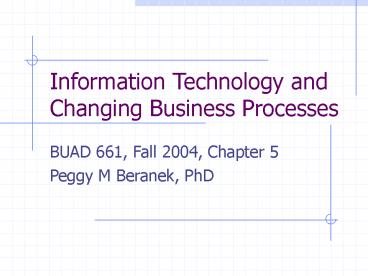Information Technology and Changing Business Processes - PowerPoint PPT Presentation
1 / 20
Title:
Information Technology and Changing Business Processes
Description:
Process Perspective ... Clarify the value that each process adds to the overall goals of the organization ... find ways to improve the process using the metric ... – PowerPoint PPT presentation
Number of Views:142
Avg rating:3.0/5.0
Title: Information Technology and Changing Business Processes
1
Information Technology and Changing Business
Processes
BUAD 661, Fall 2004, Chapter 5 Peggy M Beranek,
PhD
2
Functional (Silo) Perspective
- The organization of the company is around the
defined business functions - Each department determines its own core
competencies and works with them - This perspective is widespread and is reinforced
by business curricula
3
Functional Perspective - Benefits
- The organization can optimize expertise
- Can move experts across the functions
- It is easier to make connections and evaluations
with other organizations
4
Functional Perspective - Drawbacks
- Efforts are often re-created across departments
- There are often communication gaps
- The structure and culture across departments can
vary - Handoffs between departments are often a source
of problems - It becomes more difficult to communicate the big
picture
5
Process Perspective
- The Process perspective keeps the big picture in
mind, allows the manager to concentrate on the
work that must be done
6
Process Perspective
- An Inter-related, sequential set of activities
and tasks that turns inputs into outputs and
includes - A beginning and an end
- Inputs and outputs
- a set of tasks that transforms the inputs into
outputs - A set of metrics for measuring effectiveness
7
Leading with the Process Perspective
- Identify the customers of processes
- Identify the customers requirements
- Clarify the value that each process adds to the
overall goals of the organization - Share your perspective with other organizational
members until the entire organization becomes
process focused
8
Transforming a Business
- BPR Business Process Re-engineering
- Radical process
- Is a Core Competency for some companies
- TQM Total Quality Management
- Incremental, continuous process
- Both processes are equally important
- Both must view the business as a set of processes
9
TQM
- Small incremental changes are used to improve a
business, involves - Choosing a business process to improve
- Choosing a metric for measurement
- Enabling personnel to find ways to improve the
process using the metric - Tends to be less threatening
- You need to allow personnel the freedom to try
new ideas to improve processes
10
BPR
- Enables aggressive improvement goals
- Makes rapid, breakthrough impacts possible
- Faces greater resistance
- Used when facing major changes in the operating
environment - Used for discontinuities
11
BPR Key Aspects
- The need for Radical change
- Thinking from a cross-functional perspective
- Challenging old assumptions
- Networked, cross-functional organizations
12
BPR - Steps
- State a case for action, with an understanding of
current conditions - Assess the readiness of the organization to
change - Identify the business processes that will be
affected - Analyze those processes
13
BPR - Steps
- Analyze those processes
- Develop a Workflow diagram
- Define the scope, mission, and boundaries of the
process - Develop a high-level diagram
- Identify metrics for evaluation
- Develop a transition plan
14
Enterprise Systems - ERP
- Computer systems that support the entire
organization from a process perspective
15
ERP - Characteristics
- Integration of information flows throughout the
organization - Tend to be large commercial packages
- Which reflect industry best practices
- The systems need to be integrated with the
organizations current systems - Are evolving to Web-based and OO systems
16
ERP - Advantages
- All the modules communicate with the other
modules, reduces replication and redundancy - Allows for the effective use of organizational
Data Bases - Enforces use of standard procedures
17
ERP Drawbacks/Difficulties
- Different data formats are used throughout the
organization - Many business processes need to be re-designed
Many organizations may need to make changes to
their organizational structure - The systems are sold as suites of applications
which increases their expense
18
ERP Adoption
- Let the ERP drive the business process redesign
- New organizations
- When operational business processes are not a
competitive advantage - When the current systems are in crisis
19
ERP Adoption
- Redesign the process first then apply the ERP
- When the operations are the basis of a strategic
competitive advantage - When the features offered by the ERP do not meet
the needs of the organization - When there is
- lack of top management support
- A desire for strategic flexibility
- Highly decentralized decision making
20
Common Reasons for Failure
- Lack of senior management support
- Lack of a coherent communication program
- Introducing unnecessary or too much complexity
- Underestimating the amount of time, effort and
resources needed - Combining (or substituting) re-engineering with
downsizing































